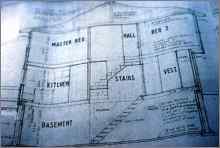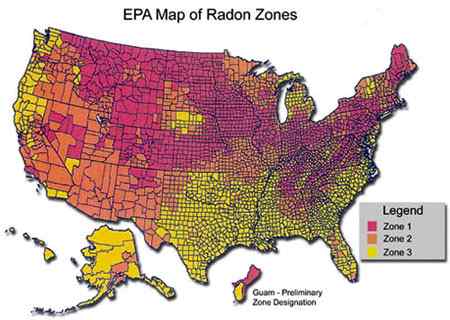|
Radon in the Home:
In What Areas and Regions is Radon the Greatest Concern?
by www.SixWise.com
Radon is a natural, radioactive gas that comes from the earth's
soil and rocks. Specifically, when uranium in the earth's
crust decays, it produces radium, which in turn produces radon.
|

Radon levels tend to be highest in basements, since
they're closest to the soil and rock.
|
This odorless and colorless gas naturally percolates through
porous soils where it enters the air. Outdoors, radon generally
is not much of a problem because it rapidly dissipates. Indoors,
however, is another story.
Radon gas can enter your home through:
Radon can even be emitted from some home building materials
such as the stone used to build fireplaces or solar heating
storage systems.
Once in, the gas accumulates in your home's indoor air. According
to the U.S. Environmental Protection Agency (EPA), nearly
one out of every
15 homes in the United States has radon levels at or above
the EPA's recommended safety level (which is four picocuries
per liter of air (pCi/L)).
Radon's Health Risks
Over time, sometimes many years, breathing in radon gas can
damage lung tissue and lead to lung
cancer. This happens because the radioactive radon particles
get trapped in your lungs and break down further, releasing
bursts of energy that can lead to cancer.
Radon is actually the second leading cause of lung cancer
in the United States (smoking is first), according to the
Surgeon General, and it's thought to be responsible for 21,000
deaths every year, according to the EPA.
|

Today many homes are built to prevent radon from coming
in, but before you purchase any home, make sure it's
been tested for radon.
|
Radon poses such a great threat because it cannot be seen,
smelled or tasted. In other words, there is no way to know,
using your five senses, that radon is leaking into your home.
Which U.S. Regions are Most at Risk?
Because radon is emitted from the soil, it's generally highest
in the basements of buildings. However, certain regions naturally
have higher levels of radium in the soil, and therefore have
the potential to emit higher levels of radon.
The EPA has put together a
map of radon levels in the United States (see image below),
showing where levels are likely to be highest. Zone 1 regions
have the highest potential for radon, followed by zone 2 and
zone 3. You can also enter
your state to find out which zone your county is in.

According to the American Cancer Society:
"The mid-Atlantic states stretching from New York through
Pennsylvania to Maryland and Virginia, as well as a broad
stretch of the upper Midwest, has geological formations that
yield higher radon levels. In contrast, radon levels are low
in the Southeast as far west as Texas and along much of the
West coast."
|
Testing Your Home for Radon is Simple:
Get Peace of Mind and Protect Your Family

One out of every 15 homes has elevated radon levels
that are the #2 cause of lung cancer in the United States.
The EPA and the U.S. Surgeon General recommend that
every home get tested below the third floor. Testing
is the ONLY way to determine if radon is in your home
because it can't be smelled, tasted or seen!
Testing your home's air for this poisonous gas is easy
with the Do-It-Yourself Home Radon Test Kit:
- Incredibly Simple to Use
- The U.S.'s top-rated & most trusted home kit
- VERY economical--Just $9.95 each!
- Contains everything for a 3-7 day radon test
- Perform simple test and mail it in ... you'll then
be able to access your home's results online!
Read
More & Order the EPA-Recommended Home Test Kit Now
|
Yet, regardless of where you live, it's still recommended
that you test the radon levels in your home, as elevated radon
levels have been found in almost every state.
Testing Your Home for Radon is Essential … and Easy
The only way to find out if your home has unsafe levels of
radon is with a radon test. That's why the EPA and the Surgeon
General recommend that all homes be tested for radon below
the third floor (schools should also be tested).
The EPA-recommended Home
Radon Test Kit that we offer on Sixwise.com is an extremely
easy, do-it-yourself kit that allows you to accurately test
for radon in your home in just three to seven days.
Radon May Also be in Your Drinking Water
Although the risk of radon in your home's air is most significant,
the U.S. Centers for Disease Control and Prevention estimates
that radon
in household water causes 30 to 1,800 deaths every year.
Because radon does evaporate readily into the air, surface
waters, such as those from lakes and rivers, are less likely
to contain high levels of the substance.
However, groundwater, which is used in wells, has not been
exposed to much air, and therefore may contain much higher
levels of radon. Wells filled by ground water supply about
half the drinking water in the United States, and if this
applies to your water supply, you can easily test your water
with our top-recommended
Radon-in-Water Test Kit. It includes everything you need
to determine your drinking water's safety.
Keep in mind that radon could be in your home right now and
you would never know it. Fortunately, radon tests are inexpensive
and an essential way to give you peace of mind that your home's
air and water are safe.
If you find that your home has unsafe levels, you should
take action immediately by hiring an experienced radon contractor
to make the necessary repairs -- the EPA says prices to reduce
radon range from $800 to $2,500 per home.
If you would like to know more about radon in your home's
air or drinking water, please read Radon
Essentials: What You Need to Know About Radon.
Recommended Reading
The
Six Silent Killers in Your Home: How to Detect and Eliminate
Them
Radon's Real Risk:
1 in 15 Homes Polluted with this #2 Cause of Lung Cancer,
but Most Don't Know It!
Sources
U.S.
Environmental Protection Agency: Radon
American
Cancer Society: Radon
American
Lung Association: Radon
|